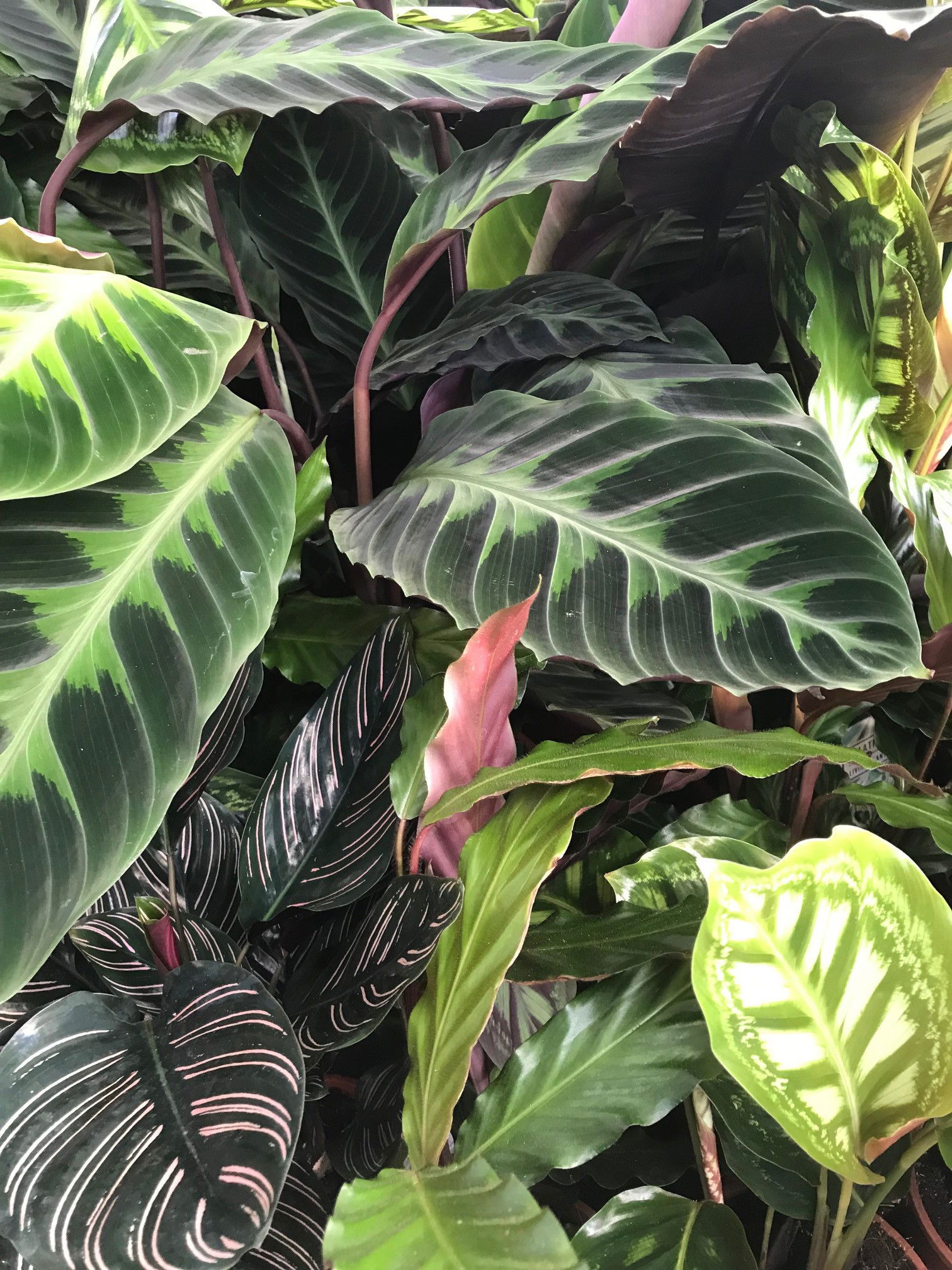
C. ornata, C. rufibarba, C. veitchiana & C. warscewiczii.
Contents
- Top Tips
- Location, Water, Humidity & Fertilisation
- The Reasoning Behind its Movement of Leaves
- Common Issues
- Origins, Temperature, Propagation, Repotting & Toxicity
Need the answer to a specific plant query? Book a 1-to-1 video call with THE HOUSEPLANT DOCTOR™, the website's friendly author, to overcome and address your niggling problem! Available on iMessage, WhatsApp, Facebook Messenger & more.
Top Tips & Info
- Care Difficulty - Moderate
- Provide a bright location with no direct light. For those that have red under-leaves, a darker place is acceptable due to the colour's functionality of reflecting the light back into the foliage.
- Overly shady sites will result in a lack of leaf-movements throughout the day & night.
- Continual moist soil is mandatory for the prevention of dehydration; allow the top few inches to dry out in between waters, reducing this slightly in the height of winter.
- Introduce a humidity tray throughout the year to provide a humid, reliable environment. Mist, or gently hose the foliage from time to time to hydrate the leaves.
- Fertilise using a 'Houseplant' labelled feed every four waters in the spring and summer, reducing this to every six in the colder months.
- Keep an eye out for Spider Mites webs that'll develop under the leaves; click on the link for more information.
- Repot every two years using a 'Houseplant' labelled potting mix, and the next sized pot with adequate drainage. Water the soil 24hrs before tinkering with their roots to reduce the risk of transplant shock.
- Why not buy our premium Calathea & Maranta Potting Mix here? We have sold over 2,100 batches in the last year alone, so click here to find out more...
Location & Light - 🔸🔸
A bright location away from the intense sun is best. If the Calathea has red undersides, a darker position in a house is also acceptable due to their ability to absorb light through the backs of their leaves. Never situate a specimen within three metres of an operating heat source, or in excessive exposure to the direct sun. A lack of movement in the leaves is primarily caused by too little light.
Water - 🔸🔸🔸
Allow the top few inches of the soil dry out between waters in the spring and summer, reducing this slightly in their dormancy. During irrigation, use lukewarm water to prevent hurting their sensitive roots from the sudden temperature change - if it's too cold for your teeth, it'll be the same with the plant, too! Rainwater is best; however, if you choose to use tap water, allow it to stand for 24hrs to settle the chloride and fluoride that may lead to damage over time. Under-watering symptoms include crispy or distorted new growth, curled leaves, crispy or dry patches and yellow areas - scroll down to 'Common Issues' for more advice on addressing this problem. Over-watering symptoms include rapidly yellowing leaves, leaf spot disease, stem collapse and plant death. Survival rates are minimal when extended root rot takes over; click on this link for further advice on this disease.
Humidity - 🔸🔸🔸
Create a humidity tray to provide a moist and stable environment for a long-lasting specimen. If the surrounding saturation is too low or the heat too high, its leaves may start to brown over and curl, especially in direct sunlight. Hose the foliage down from time to time to hydrate the leaves and keep the dust levels down.
Fertilisation - 🔸
Feed every four waters during the growing period and every six in the autumn and winter, using a 'Houseplant' labelled fertiliser. Never apply a 'Ready to Use’ product into the soil without a pre-water first, as it may burn the roots and lead to yellowed leaves.
 This image shows a new rhizomatous shoot appearing above the soil line that'll develop into its own specimen.
This image shows a new rhizomatous shoot appearing above the soil line that'll develop into its own specimen.
What's the reasoning behind its movement of leaves?
Not only do they provide a 'jungle-vibe' via their foliage patterns, but they also have a fascinating talent - nyctinastic responses. 'Nyct' refers to the nighttime (think about the word for 'night' in German, Nacht), whereas the 'nastic' refers to plant movement. The motor organs, or pulvinus for botanists, swell and relax depending on the time of day, acting as a valve below the leaf's base.
There are many different types of nastic responses that plants can make; all of which are caused by external factors or stimuli. Mimosa pudica has thigmonastic characteristics where the plant folds its leaves one by one to make itself look dead and unattractive. This way, the predators would at least think twice about destroying a spindly weed, as it appears to be underdeveloped and therefore nutrient deficient. With Calatheas, however, it's not entirely known why they do this; some believe its to protect the leaves and conserve water, whereas others lean towards the idea of disinteresting predators. Either way, you can certainly agree that it's super fascinating to see the contrast of its positions between both night and day.
Common Issues with Calathea (Prayer Plants)
Curled leaves and brown leaf-edges are the result of too little water or over-exposure to the sun. Calathea are best located in bright, indirect settings, and those that haven't acclimatised to the harsh rays will show signs of sun-scorch and environmental shock. A splash of winter sunlight is acceptable as long as the soil moisture is regularly observed, with complete avoidance once summer comes along.
When a Calathea is severely dehydrated, most of its leaves will crisp-up and fall off - leaving you with a naked plant. Although it may spell the end of juvenile plantlets, there may still be light at the end of the tunnel for more established specimens. If the stems and leaves are thoroughly crisp, prune the stems to around an inch from the soil line and contain the plant (with its pot) in a transparent bag that has small holes. Keep the soil continually moist, providing a good level of indirect light and temperatures above 15°C (59°F). After a few weeks, new rhizomatous growths will form above the soil line, signalling the start of its recovery process. Remove from the bag once the plant produces its third new leaf.
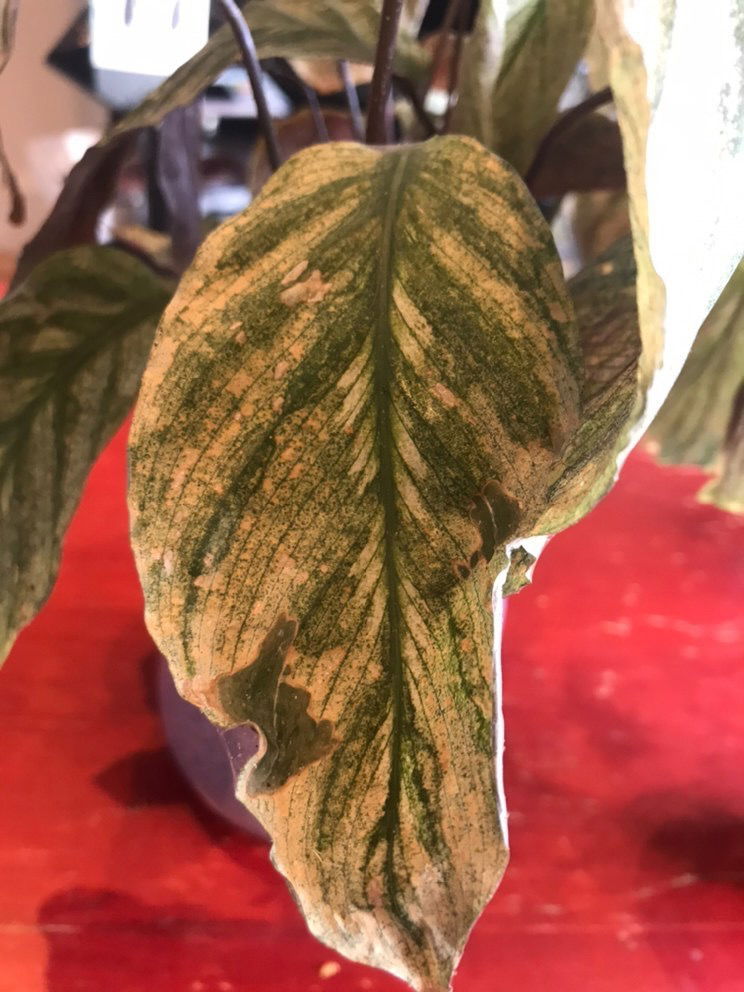 Spider Mites are small, near-transparent critters, that'll slowly suck out the chlorophyll out of the leaves. Have a check under the leaves, most notably along the midrib, for small webs and gritty yellow bumps. Click here to read our article about the eradicating Spider Mites, along with some extra tips that you may not find elsewhere!
Spider Mites are small, near-transparent critters, that'll slowly suck out the chlorophyll out of the leaves. Have a check under the leaves, most notably along the midrib, for small webs and gritty yellow bumps. Click here to read our article about the eradicating Spider Mites, along with some extra tips that you may not find elsewhere!
Root rot is a common issue with specimens sat in too moist or waterlogged soil for long periods. Symptoms include rapidly yellowing leaves, stunted growth and a rotten brown base. Take the plant out of the pot and inspect health below the soil line. If the roots sport a yellow tinge, you're good to go, but if they're brown and mushy, action must be taken immediately. More information about addressing root rot can be found on this link.
Too low humidity can cause browning tips with yellow halos on juvenile leaves. Although this won't kill your specimen, you may want to increase the local moisture to prevent the new growth from adopting these symptoms. Mist or rinse the foliage from time to time and create a humidity tray while the heaters are active to create a stable environment. The browning of leaf-tips on older leaves is wholly natural and is the product of extensive photosynthesis during its life.
Transplant shock is a big issue when it comes to heavy-handed repots. Give the plant a good soak 24hrs before the action and never tinker with the roots, unless it has been affected by root rot. Typical signs of transplant shock are largely similar to under-watering, with wilting, yellowing leaves and stunted growth among the most common symptoms. Click here to learn more about addressing transplant shock, and a step-by-step guide on performing the perfect transplant.
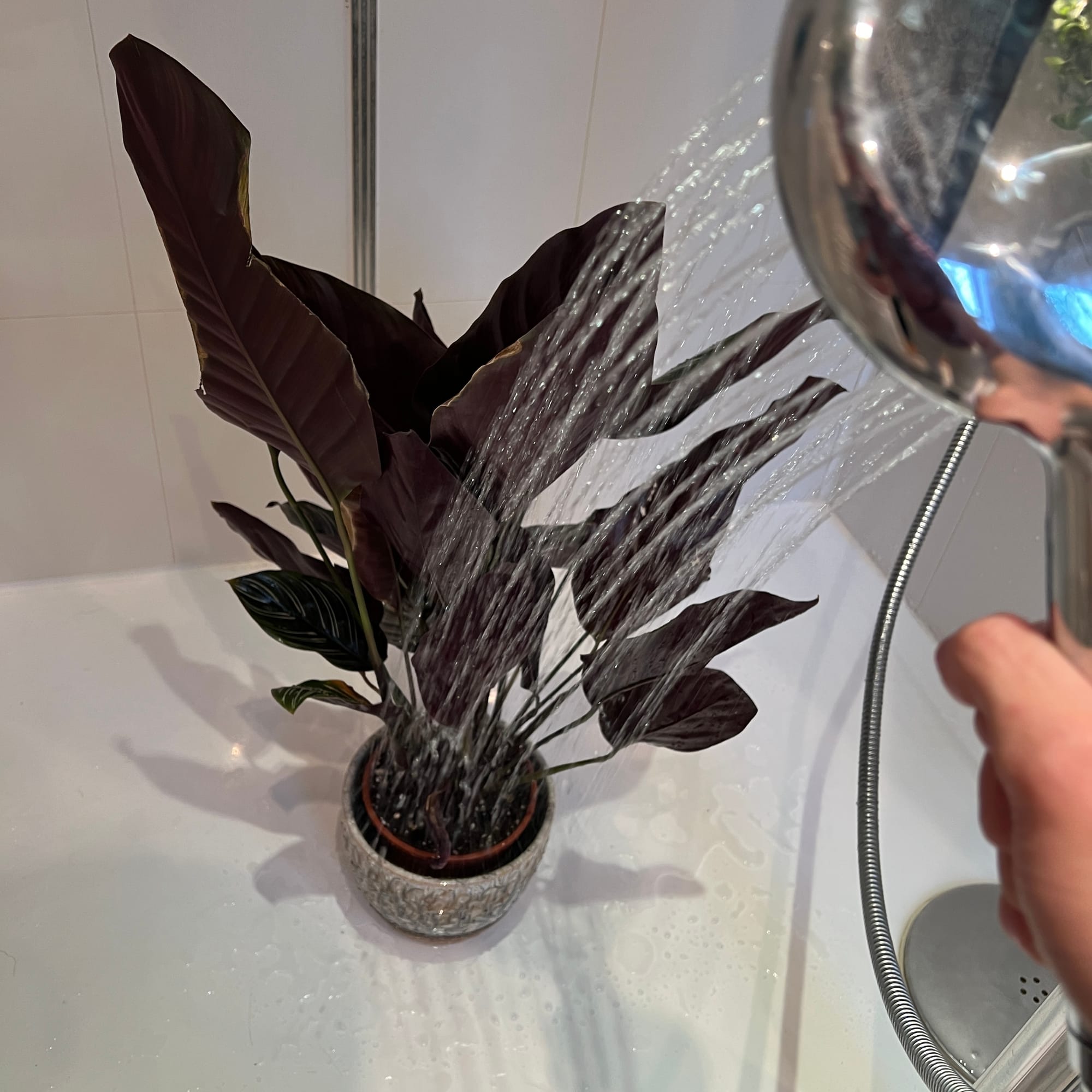
Dust or rinse the leaves regularly. Although this isn't too much of an issue, a build-up of dust particles can clog up the plant's pores, causing lowered light capturing-efficiency. Wipe the topsides of the leaves down once a month to keep levels down and improve growing conditions. THE HOUSEPLANT DOCTOR™ recommends rinsing the foliage once a month in the show (with lukewarm water).
Mould developing on the soil means two things - too little light and over-watering. Despite the harmlessness of the mould, it'll prove unsightly to most gardeners and is therefore removed once known. To remove, replace the top two inches of the soil for a fresh batch of 'Houseplant' compost. Either increase the amount of light received (no direct sunlight for the first few weeks to prevent environmental shock) or decrease the frequency of waters slightly. If the mould is accompanied by yellowing lower leaves, you may also have a case of root rot.
Too little light could cause the nyctinastic moments (folding of leaves) to only respond for a fraction of the day, usually accompanied by little to no new growth and gradual decline. Remember to provide a location that is at least bright enough to read a newspaper, and always avoid prolonged exposure to direct light.
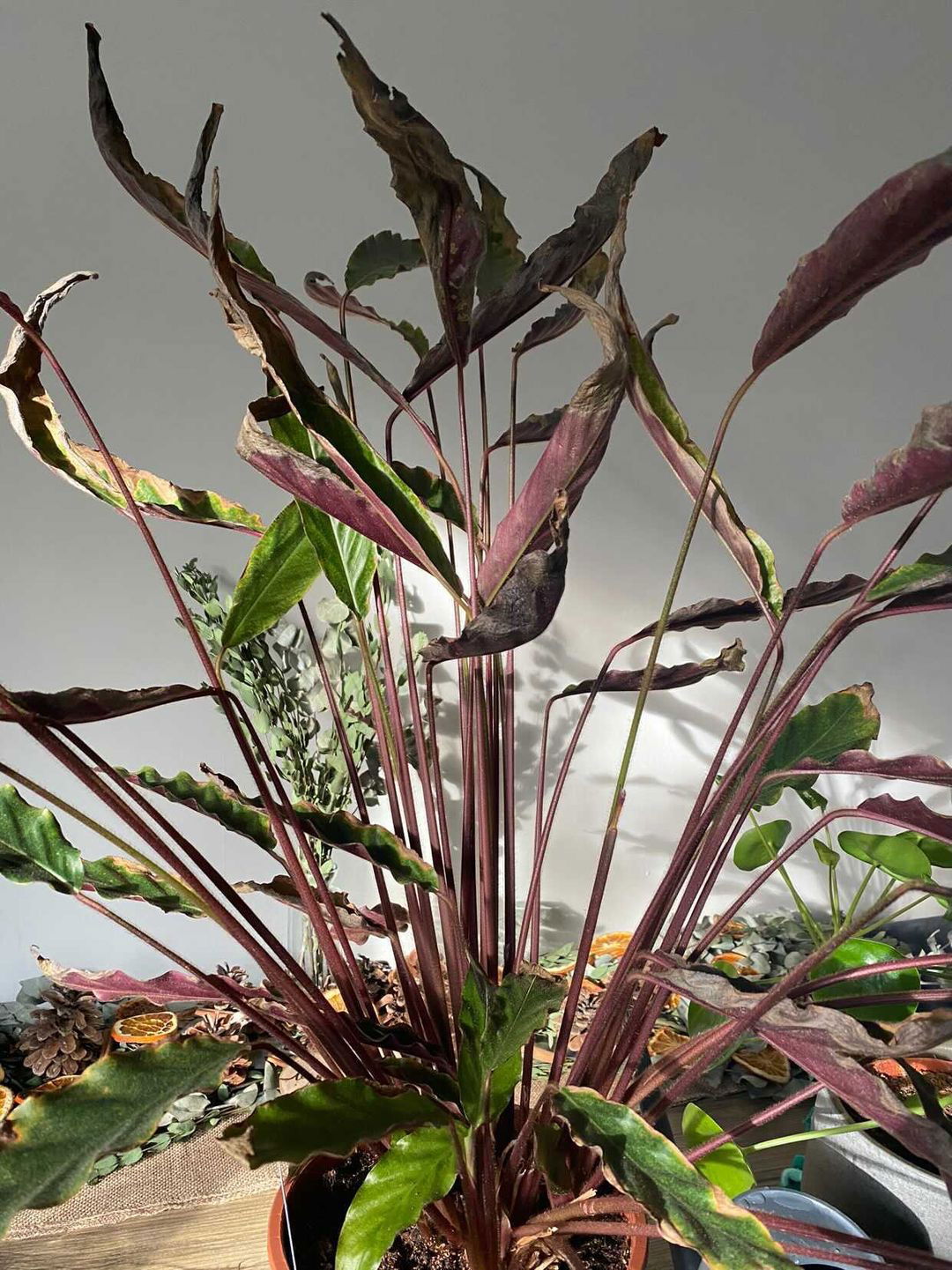 If your Calathea begins to look like this, cut off all of its leaf-stems so that you're left with just the stem. Give the plant a good fertilise and introduce a humidity tray for better humidity levels. If the plant still holds enough energy, it'll begin to grow new leaves in the coming months!
If your Calathea begins to look like this, cut off all of its leaf-stems so that you're left with just the stem. Give the plant a good fertilise and introduce a humidity tray for better humidity levels. If the plant still holds enough energy, it'll begin to grow new leaves in the coming months!
Origins
Calathea is mainly used for the transportation of small items like fish and rice in South America (mainly Brazil). The genus was first described in 1822 by Georg Meyer, with the type-species, C. lutea (originally C. discolor) being penned by Jean Fusée-Aublet later that year. Some species have edible tubers, grown for starch, while others produce wax to make waterproof baskets because of their durable leaves. Calathea, as a whole, has been broken up many times over the decades, with many being re-classified as Goeppertia.
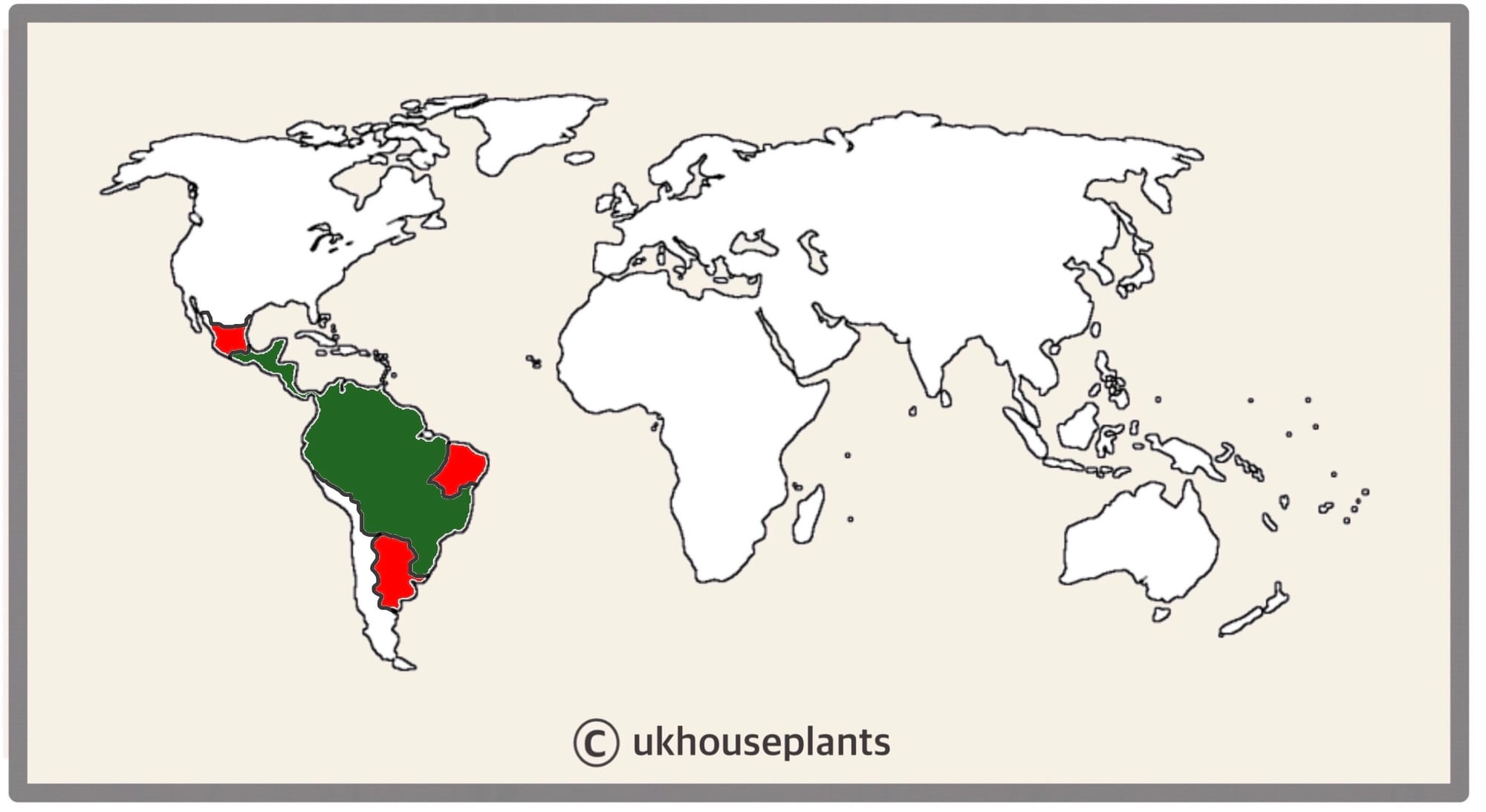 The Distribution of Calathea & Goeppertia in Green. Additional nativity of the latter is in Red.
The Distribution of Calathea & Goeppertia in Green. Additional nativity of the latter is in Red.
Temperature
12° - 27°C (54° - 80°F)
H1b (Hardiness Zone 12) - Can be grown outdoors during the summer in a sheltered location with temperatures above 12℃ (54℉), but is fine to remain indoors, too. If you decide to bring this plant outdoors, don't allow it to endure any direct sunlight as it may result in sun-scorch and dehydration. Regularly keep an eye out for pests, especially when re-introducing it back indoors.
Spread
Up to 70cm in both height and width. Once they either flower or reach maturity, growth will be limited to almost none, with new rhizomatous growth developing through the soil-line.
Pruning & Maintenance
Remove yellow or dying leaves, and plant debris to encourage better-growing conditions. While pruning, always use clean utensils or shears to reduce the chance of bacterial and fungal diseases. Never cut through yellowed tissue as this may cause further damage in the likes of diseases or bacterial infections. Remember to make clean incisions as too-damaged wounds may shock the plant, causing weakened growth and a decline in health.
Cut any dying stems to around an inch from the soil line, allowing new growth to develop from its rhizomes. In some instances, you'll have to remove all of the stems, leaving just a bare pot of soil. As long as you provide moist soil and a well-lit location, new growth will appear within a few months. Do not repot or separate the rootstocks during this time, as it'll lead to transplant shock and inevitable death.
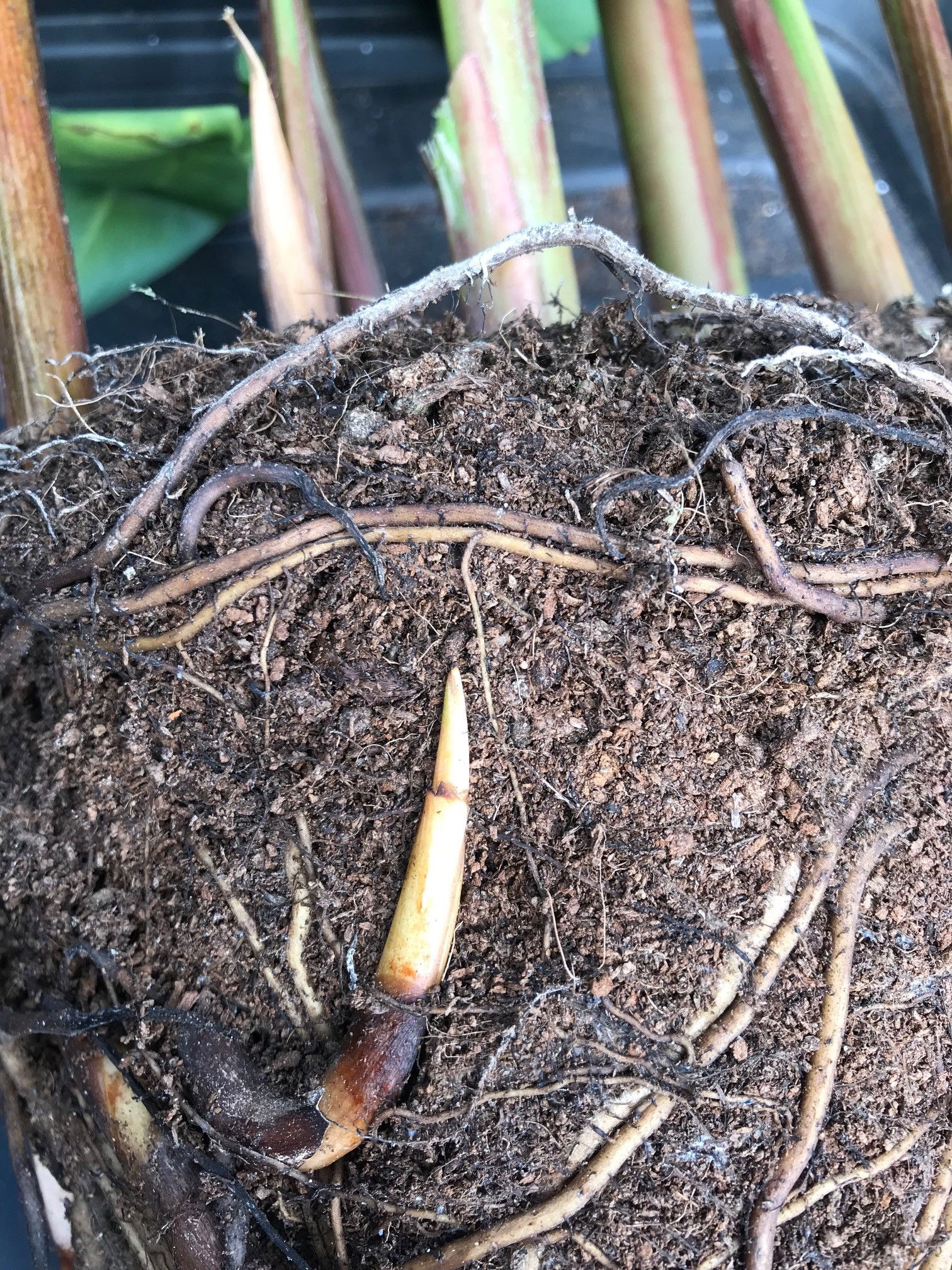 Here is a rhizomatous growth that'll develop into its own stem in due course.
Here is a rhizomatous growth that'll develop into its own stem in due course.
Propagation
Via Seed, Rhizome (Offset) Division or Stem Cuttings.
Rhizome or Offset Division (Moderate) - Separating the basal offsets into their own pot will not only expand your plant collection, but it'll also slow the process of becoming pot bound. The best time to divide is during the spring, with the pup's height surpassing 20cm (7.8 inches). Gently brush away some of the soil to gain better access to the pup's base (lower stem) where the roots will be housed. While using a clean pair of secateurs or scissors, cut the stem with at least two root strands attached to its base. Set the pup in an appropriate-sized pot with adequate drainage and a 'Houseplant' labelled compost. The ideal location would provide bright, indirect light and temperatures above 15℃ (59℉). Maintain evenly moist soil, allowing the top third to dry out in between hydrations. After a month or two, treat it like a matured specimen by using the care tips mentioned above!
Stem Cuttings via Water - (Moderate)
- Choose the healthiest, most established sections that have no visible signs of pests or diseases. This propagation method can be taken from spring to summer, with the stem being at least 20cm (7.8 inches) in length with two or three leaves.
- Cut directly below a node (leaf) using a clean knife to reduce bacteria count. Remove the lower half of the leaves and place the vines into a container of lukewarm water. Be sure to submerge at least one node into the water, or else the root development will be hindered.
- The leaves must stay above the water line to prevent disease.
- Replace the water weekly, using lukewarm water to avert shocking the cutting with cold temperatures.
- Once the roots surpass 3cm (1.1 inches) in length, it's time to pot the specimen.
- Choose a suitable potting mix to pot up your plant. 'Houseplant' compost is best, but a multi-purpose compost with a splash of grit or perlite is also acceptable. We also sell Calathea & Maranta potting soil with free delivery via this link.
- Use a 10cm pot that has good drainage holes - plastic or terracotta are both acceptable in this instance. Try not to over-pot the cuttings; 'blackleg' occurs when the bottom wound becomes infected, typically caused by water-logging or a too-damaged wound.
- Set the cutting into the compost, keeping the foliage above the soil line.
- Avoid direct sunlight and offer good humidity by placing the potted plants into a transparent plastic bag with holes for the first couple of weeks.
- Open the bag every two days for half an hour for the prevention of disease. After a month of being placed in soil, remove it from the bag and follow the care tips provided above.
Flowers
Most Calathea will rarely flower indoors, due to the insufficient growing conditions. The only exception is the C. crocata, whereby it's sold for both its foliage and beautiful orange flowers that are on show in the latter stages of summer.
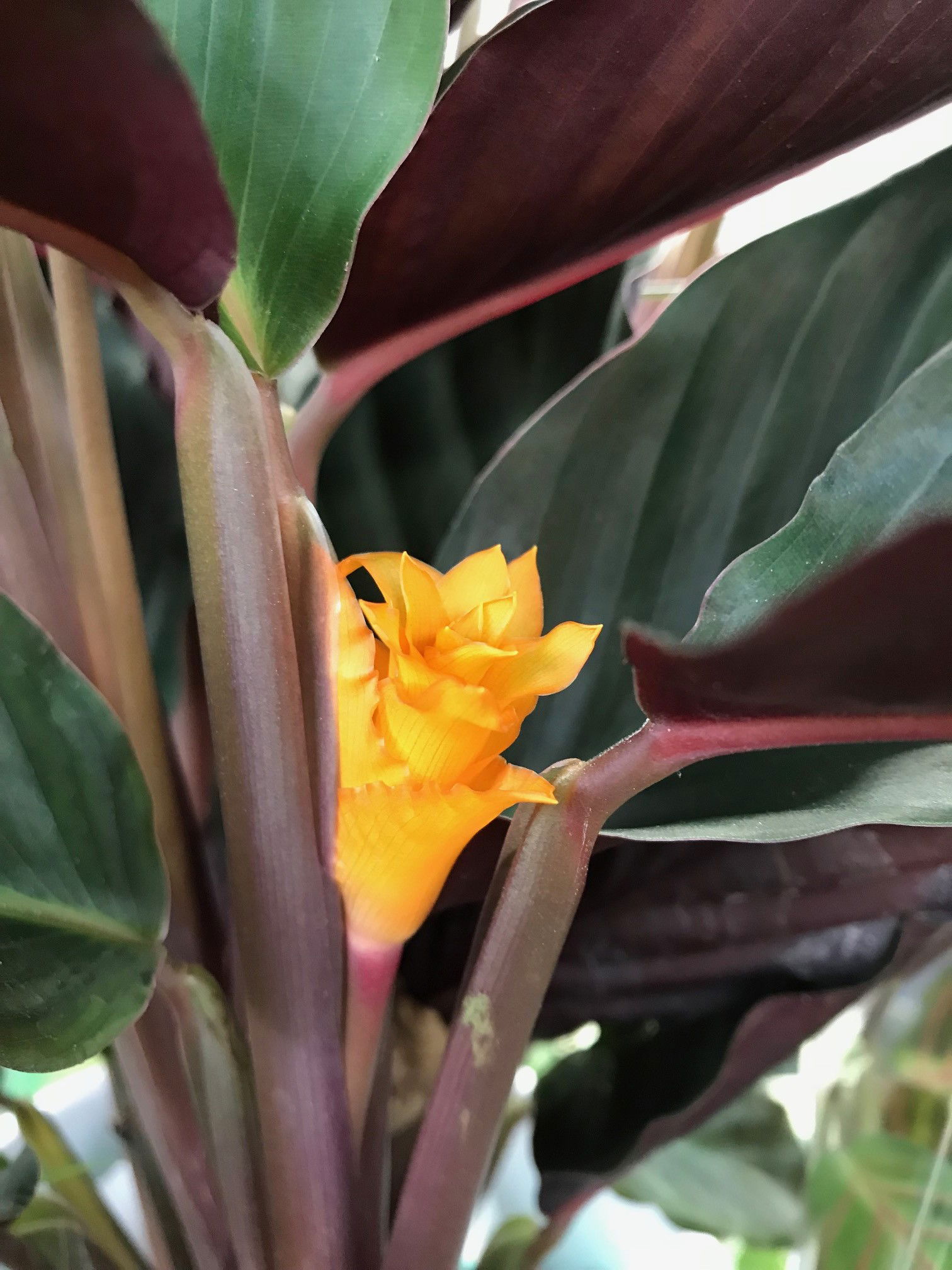 An inflorescence of the C. crocata.
An inflorescence of the C. crocata.
Repotting
Repot every two years in the spring, using a 'Houseplant' labelled compost and the next sized pot with adequate drainage. Hydrate the plant 24hrs before tinkering with the roots to prevent the risk of transplant shock. For those that are situated in a darker location, add a thin layer of small grit in the pot's base to improve drainage and downplay over-watering. Click here for a detailed step-by-step guide on transplantation, or via this link to learn about repotting with root rot.
Small swollen nodules will develop along the Calathea's roots which can store both water and nutrients (nitrogen mainly) for potential droughts. Do not remove them as it may lead to stress on the specimen. Spider Plants also have the same root mechanism, however, with the latter they'll develop into cylindrical growths, instead of near-perfect balls.
Book a 1-to-1 video call with THE HOUSEPLANT DOCTOR™ if you'd like a personal guide to repotting your houseplant. This will include recommending the right branded-compost and pot size, followed by a live video call whilst you transplant the specimen for step-by-step guidance and answer any further questions!
Pests & Diseases
Keep an eye out for mealybugs, spider mites, scale, thrips & whitefly that'll locate themselves in the cubbyholes and undersides of the leaves. Common diseases associated with Calathea are root rot, leaf-spot disease, botrytis, rust, powdery mildew & southern blight - click here to learn more about these issues.
Toxicity
Not considered to be poisonous by consumption of pets and humans; if high quantities are eaten, it may result in vomiting, nausea and a loss of appetite.
Retail Locations
Dobbies, IKEA, B&Q, Blue Diamond, Online Stores.
Book a 1-to-1 Call with THE HOUSEPLANT DOCTOR™
If you need further advice with your houseplants, book an advice call with ukhouseplants' friendly and expert writer today! This can be done via a video or audio call on most apps, including Facebook, FaceTime & Skype. A ten-minute call costs £5.99 (US$7), or £15.99 for thirty minutes. You can ask multiple questions, including queries on plants, pests, terrariums, repotting advice and anything in between. Please consider supporting this service to keep ukhouseplants thriving!